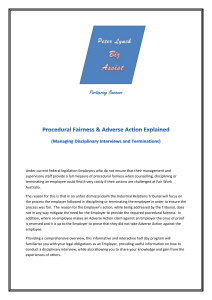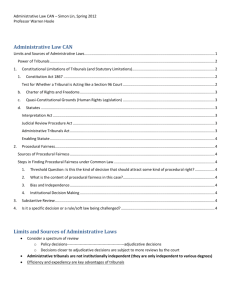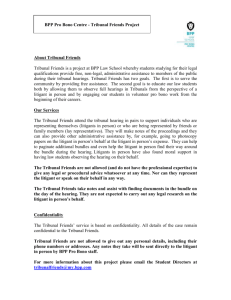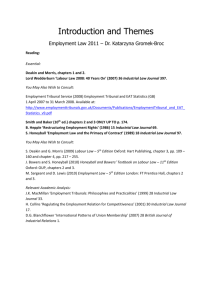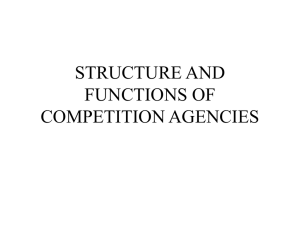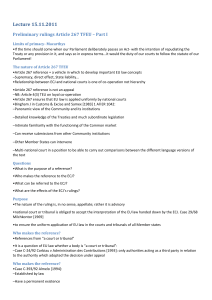institutional fairness
advertisement
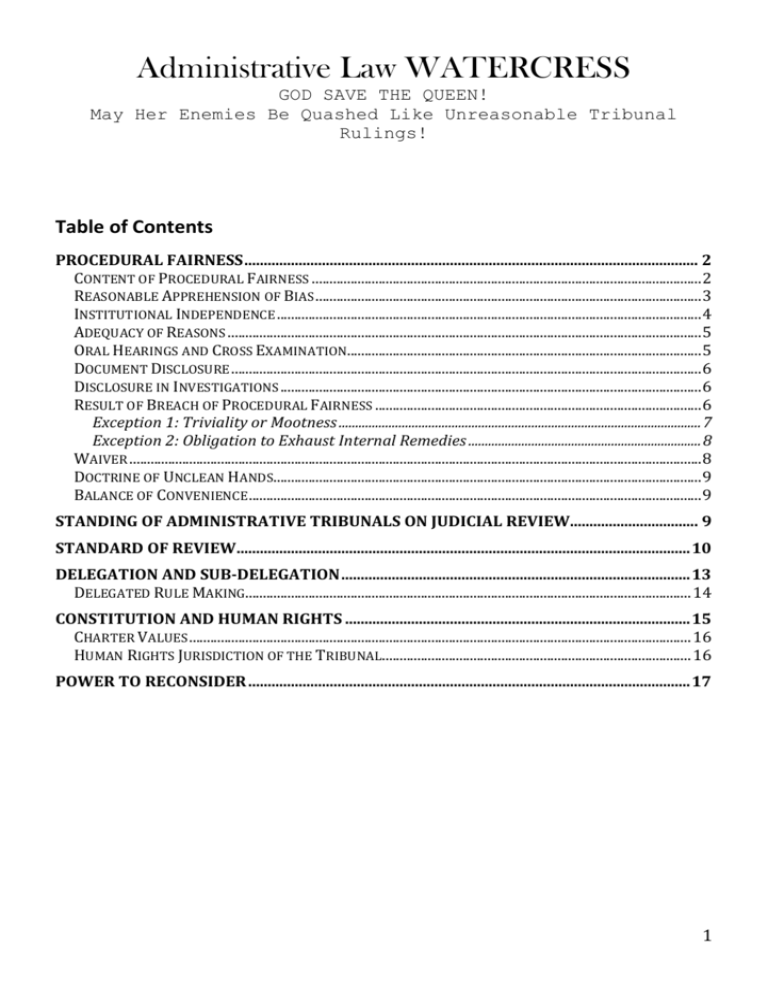
Administrative Law WATERCRESS GOD SAVE THE QUEEN! May Her Enemies Be Quashed Like Unreasonable Tribunal Rulings! Table of Contents PROCEDURAL FAIRNESS ..................................................................................................................... 2 CONTENT OF PROCEDURAL FAIRNESS ............................................................................................................... 2 REASONABLE APPREHENSION OF BIAS .............................................................................................................. 3 INSTITUTIONAL INDEPENDENCE ......................................................................................................................... 4 ADEQUACY OF REASONS ....................................................................................................................................... 5 ORAL HEARINGS AND CROSS EXAMINATION..................................................................................................... 5 DOCUMENT DISCLOSURE ...................................................................................................................................... 6 DISCLOSURE IN INVESTIGATIONS ........................................................................................................................ 6 RESULT OF BREACH OF PROCEDURAL FAIRNESS ............................................................................................. 6 Exception 1: Triviality or Mootness ............................................................................................................. 7 Exception 2: Obligation to Exhaust Internal Remedies ...................................................................... 8 WAIVER ................................................................................................................................................................... 8 DOCTRINE OF UNCLEAN HANDS.......................................................................................................................... 9 BALANCE OF CONVENIENCE ................................................................................................................................. 9 STANDING OF ADMINISTRATIVE TRIBUNALS ON JUDICIAL REVIEW................................. 9 STANDARD OF REVIEW ..................................................................................................................... 10 DELEGATION AND SUB-DELEGATION .......................................................................................... 13 DELEGATED RULE MAKING............................................................................................................................... 14 CONSTITUTION AND HUMAN RIGHTS ......................................................................................... 15 CHARTER VALUES ............................................................................................................................................... 16 HUMAN RIGHTS JURISDICTION OF THE TRIBUNAL........................................................................................ 16 POWER TO RECONSIDER .................................................................................................................. 17 1 Procedural Fairness Nicholson v. Haldimand Norfolk (Regional) Police Commissioners (SCC, 1979): -If the rights, entitlements, interests or obligations of a party are being affected by a decision-maker, then a right to procedural fairness arises. Cardinal v. Kent Institution (SCC, 1985): -Procedural fairness applies to every public authority making an administrative decision that is not of a legislative nature and which affects the rights, privileges, or interests of an individual (paragraph 14). -A breach of procedural fairness, whether it results in substantive unfairness or not, will result in a quashing of the decision. It does not matter if outcome will be the same. -Emergency circumstances can result in temporary suspension of procedural fairness (but not its permanent abolition). Knight v. Indian Head School Division No. 19 (SCC, 1990): -Content of the duty of procedural fairness is imminently variable. In this case, it was satisfied by discussions between employer and employee. -Three factors to look at in determining whether the right to procedural fairness arises: 1.) look at nature of decision being made by administrative body in question. Considerations include: is the decision specific to a narrow group of parties? Is it administrative in nature or policy related? Is it final? (interim decisions are not subject to judicial review on procedural fairness grounds). 2.) Relationship existing between body in question and individual: if the relationship is of master and servant, that is a pure employment relationship and there is no right to procedural fairness—just look to employment law to resolve dispute. If office holder or office holder at pleasure, then some right to fairness will arise. (applies only in employment settings) 3.) Consider how the decision affects the individual’s rights. “There is a right to procedural fairness only if the decision is a significant one and has an important impact on the individual.” Attorney General of Canada v. Inuit Tapirisat et al (SCC, 1980): -Legislative action, such as a decision being made by the governor-in-counsel, is not subject to a duty of procedural fairness. -In order to ascertain whether the statutory decision-maker is subject to a duty of fairness, it is necessary to examine the statute in order to determine the legislature’s intent. Reference Re Canada Assistance Plan (B.C.) (SCC, 1991): -Legitimate expectations cannot give rise to substantive rights or outcomes but can give rise to procedural requirements (i.e., procedural fairness). You can have legitimate expectations about process. Content of Procedural Fairness Baker v Canada (SCC, 1999): 2 -Five factors for calibrating the degree of procedural fairness that is appropriate in a given case: 1.) Nature of decision being made and the process followed in making it. The more this looks judicial, the greater the degree of fairness will be required. 2.) Nature of statutory scheme and terms pursuant to which the body operates. E.g., if there a right to appeal to some other body, then initial decision will require less fairness. If quick turn around time, then less fairness will be owed. 3.) The importance of the decision to the individual(s) affected. The more important (the greater the impact on their life), the more stringent protections are required. 4.) Legitimate expectations of the parties in terms of what procedure should be used. Legitimate expectations can create procedural, but not substantive, rights. Look to applicable act and relevant documents about the tribunal. 5.) Choice of procedure made by agency itself. Some weight should be given to tribunal’s choice of procedure because of its specialty in that area. -Note: first apply Nicholson, AG Canada v Inuit Tapirisat, Reference Re Canada Assistance Plan (B.C.), Cardinal and Knight to determine whether procedural fairness is required. If required, then use Baker factors to determine content of the duty of procedural fairness required. -Requirement to give adequate reasons comes from Baker. -Standard for reasonable apprehension of bias on reasons: would an informed person viewing the matter realistically and practically, and having thought the matter through, think it was decided fairly? Decided on balance of probabilities. Reasonable Apprehension of Bias Committee for Justice and Liberty v. NEB (SCC, 1978): -Minority judgment contains test for reasonable apprehension of bias: “what would an informed person with knowledge of all the circumstances, viewing the matter realistically and practically—and having thought the matter through—conclude”? -Note: it is not a “very sensitive or scrupulous conscience” that is apprehending the bias. -Policy consideration: if you want people with expertise and you don’t want them to have to recuse themselves all the time, you have to give tribunal members leeway to distance themselves from their prior connections. -Sworn oath to uphold the statute fee of bias is a factor militating against the finding of a reasonable apprehension of bias. Newfoundland Telephone v Newfoundland (SCC, 1992): -Once the hearing begins, the tribunal member must appear to be at least open to being persuaded. -Pre-hearing comments will not necessarily give rise to reasonable apprehension of bias, especially if decision is on political end of spectrum unless the comments give rise to the impression of a closed mind on the part of the tribunal member. 3 Institutional Independence R v. Valente (SCC, 1985): -When you are evaluating the institutional independence of a decision-making body (not a specific tribunal member), then you should consider the following: 1.) the security of tenure of the adjudicator (if not secure, then cabinet might taint them); 2.) the financial security of the adjudicator (is there a long term contract? An instrument that requires the tribunal members to be paid?); 3.) the administrative independence of the tribunal (does the executive have day to day control of the tribunal? Who decides who hears what cases and what resources are available). -Standard is objective observer, not an unduly suspicious person like a conspiracy theorist. -When you are asking for judicial review a decision based on procedural fairness, you can use these factors to argue that the tribunal is not sufficiently independent. IWA v. Consolidated-Bathurst Packaging Ltd (SCC, 1990): -Adopts Valente and confirms its applicability to tribunals. -It is okay for tribunals to hold big meetings where draft decisions are distributed provided that the original findings of fact are not questioned and discussion is limited to policy implications. Kozac (Geza) v. Canada (FCA, 2006): -Test is for lack of institutional independence is same as reasonable apprehension of bias “in a substantial number of cases.” -In applying the institutional independence test or the bias test, the reasonable person is not to be equated with either the losing parties or the unduly suspicious. Canadian Pacific Ltd. v. Matsqui Indian Band (SCC, 1995): -You have to exhaust internal remedies before seeking judicial review unless the internal remedies are procedurally unfair due to a lack of institutional independence. 2747-3174 Quebec Inc. v. Quebec (Regie des permis d’alcool): -Quebec Charter expressly protects the independence and impartiality of tribunals. Prevents legislation from undermining institutional independence of tribunal. Ocean Port Hotel Ltd. v. British Columbia (SCC, 2001): -The degree of independence required of tribunal members may be ousted by express statutory language or necessary implication. No Quebec Charter in BC. Khan v. College of Physicians and Surgeons of Ontario (ONCA, 1992): -Tribunal may receive outside assistance in writing reasons without undermining the institutional independence of the tribunal. McKenzie v. Minister of Public Safety and Solicitor General et al. (BCSC, 2006): -Statutory office holders have a right to procedural fairness on their termination (contradicted by Dunsmuir on this issue). 4 -Where the tribunal is performing a function that used to be performed by the BCSC, then the tribunal needs to have a higher degree of institutional independence than would otherwise be the case. This puts it at the judicial end of the spectrum. -It is possible to argue that a statutory removal of institutional independence offends the rule of law (BCSC decision, overruled on other grounds). Adequacy of Reasons Gichuru v. Society of BC (BCCA, 2010): -Reasons do not need to address tangential or irrelevant issues. Newfound Nurses v. Newfoundland (SCC, 2011): -For non-ATA tribunals and tribunals outside of BC, procedural fairness requires that there be reasons (standard is same as Baker: “words on a page”). -Adequacy of reasons is moved to standard of review of analysis. Adequacy of reasons informs the reasonableness of the decision. Phillips v. BC Worker’s Compensation Appeal Tribunal (BCCA, 2012): -Adequacy of reasons is same for ATA as non-ATA tribunals; however, this may not an accurate interpretation of the ATA. Oral Hearings and Cross Examination Singh v. Minister of Employment and Immigration (SCC, 1985): -S. 7 of the Charter and s. 2(e) of the Canadian Bill of Rights require that an oral hearing be held in the following circumstances: -where there is a serious factual complexity; -where there is a need for an immediate back and forth question and answer between the panel and the parties; -where the central issue is credibility. -This case only applies where your rights under s. 7 or s. 2(e) are engaged. Must be judicial end of the spectrum. Innisfil Township v. Vespra Township (SCC, 1981): -If a statute doesn’t disallow cross-examination, then the common law allows for crossexamination. This is particularly significant where expert evidence is involved. -A breach of the right to cross-examine is always procedurally unfair. It is not for the court to assess the outcome of cross-examination. Re County of Strathcona No. 20 v. Maclab Enterprises Ltd. (ABCA, 1971): -If there is an alternative to cross-examination that is equally effective, then there is no requirement to allow for cross-examination. Djakovic v. British Columbia (Workers’ Compensation Appeal Tribunal) (BCSC, 2010): 5 -Cross-examination may be required where the hearing is at the judicial end of the spectrum, the right or entitlement at issue is significant, and memory or credibility is at issue. Johnson v. Alberta (Appeals Commission for Alberta Workers' Compensation) (ABCA, 2011): -Where there are competing expert opinions in evidence, cross-examination may be required. Document Disclosure Kane v. University of British Columbia (SCC, 1980): -A high level of procedural fairness applies when dealing with a professional’s employment. Anything the tribunal intends to rely on must be disclosed. ATA, s. 34(1): governs summoning witnesses and disclosing documents. -A party to a tribunal hearing may prepare and serve a summons in accordance with tribunal procedure to (a) require a person to attend an oral or electronic hearing for the purpose of giving sworn evidence; (b) to produce documents or other things for disclosure that are relevant to an issue in the hearing. S. 34(2): (a) a party may apply to the court for an order (a) directing a person to comply with a summons served under 34(1) or (b) directing the directors or officers of the person to cause the person to comply with a summons served by a party under 34(1). 34(3): tribunal has the power to make orders to attend hearing or produce documents at any time during a hearing before making a decision in the case. 34(4): tribunal may apply to the court for an order (a) directing a person to compny with an order under s. 34(3) or directing the directors and officers of a person to cause the person to comply with an order made by the tribunal under s. 34(3). ATA s. 40(3): -Admissibility of evidence is subject to same constraints as under Canada Evidence Act, BC Supreme Court Civil Rules, and the common law. Disclosure in Investigations Swanson v. Institute of Chartered Accountants of Saskatchewan (SKQB, 2007): -When you are being investigated, you have the right to be informed of the identity of the complainant (subject to limitations) and the nature of the complaint. You also have entitled to give some input into the investigative process and speak with the investigator. -If you become aware of the investigation through unofficial channels, you will be deemed to be have been informed of the investigation. Result of Breach of Procedural Fairness There are five exceptions to the rule in Cardinal that if your procedural fairness right is breached, you automatically get a new hearing: 6 -Exception 1: Triviality or Mootness: if the procedural error is so trivial that it couldn’t possibly have changed the outcome of the decision, then there should be no remedy for the breach (triviality). Mootness: there is no point in having a new hearing if the central issue has been bypassed by later events or has been resolved. -Exception 2: Obligation to Exhaust Internal Remedies, Prematurity, and Curing: where there is at least one avenue of redress in a tribunal silo, then the party seeking review of the initial tribunal decision must pursue that avenue before seeking judicial review (exhausting internal remedies). Curing is the doctrine where a failure of procedural fairness occurs at a lower level in the silo and a higher level of the silo can cure it. Prematurity states that rulings made in the course of a tribunal’s proceedings should not be challenged until the tribunal’s proceedings have been completed. -Exception 3: Waiver: you can waive your procedural fairness rights. -Exception 4: Doctrine of Unclean Hands. -Exception 5: Balance of Convenience: Court will consider whether the decision is worth quashing on a balance of convenience. Exception 1: Triviality or Mootness Westfair Foods Ltd v. United Food and Commercial Workers’ Union (ABCA, 2007): -Triviality. -Where there is nothing new or significant in the post-hearing submissions, then a breach of procedural fairness related to those submissions will not justify the quashing of the decision. Compass Group Canada (Health Services) v. Hospital Employees’ Union (BCCA, 2007): -Triviality. -If the breach was insignificant and the Court knows with near certainty that the decision be the same if it is quashed and sent back to the tribunal, then the court will uphold the decision because there is no practical utility in sending it back. Moose Jaw Central Bingo Assn. v. Saskatchewan (SKCA, 1994): -Mootness. -Remedies of mandamus and certiorari are discretionary and flow from inherent jurisdiction of the court. If granting the remedy would be futile, the Court retains the power to withhold the remedy even if there was a breach of procedural fairness. Bago v. Canada (FC, 2004): -Court must be very cautious in striking out judicial review applications. Mootness is an exceptional circumstance. -Three policy considerations underlying the doctrine of mootness: 1.) the existence of an adversarial context; 2.) judicial economy and conservation of judicial resources; and 3.) a need for the Court to demonstrate awareness of its proper function. Mobil Oil Canada v. Canada-Nfld. Offshore Petroleum Board (SCC, 1994): -Where the legal outcome is certain, then sending the matter back to the tribunal would be moot. 7 Exception 2: Obligation to Exhaust Internal Remedies Harelkin v. University of Regina (SCC, 1979): -Cite this case for obligation to exhaust internal remedies. -Where there is a convenient alternative remedy, the granting of judicial review is discretionary and involves considerations of expediency and expense as well as efficacious administration of justice. -The Courts should not use their discretion to promote delay and expenditure unless there is no other way to protect a right. Zundel v. Canada (FCA, 2000): -Cite this case for prematurity. -Courts do not want to fragment tribunal proceedings by permitting the judicial review of interim decisions, unless those decisions involve allegations of institutional bias. -Hoole: for claims of individual bias, you should make your complaint at the tribunal and then reserve your right to bring a judicial review application based on bias if you lose. Secord v. Saint John (NLQB, 2006): -Where you are arguing that the tribunal has no jurisdiction, you can seek judicial review right away (exception to Zundel). Taiga Works v. BC (BCCA, 2010): -Tribunal silos should be able to cure procedural defects at lower levels of the silo. Where the tribunal silo cannot cure the defects, then judicial review is available. Waiver Allard v. Assessor of Area #10 (BCCA, 2010): -If you don’t press the tribunal on breaches of procedural fairness, you may be deemed to have waived your procedural fairness rights. You need to put your complaint on the record. Cougar Aviation Ltd v. Canada (FCA, 2000): -Allegations of reasonable apprehension of bias must normally be raised at the earliest practicable opportunity. If not taken in a timely fashion, an objection will be regarded as waived. -Cannot be used by the unsuccessful party to impugn the validity of the decision if there have been no objections. If you don’t raise the allegation of bias at the tribunal, you are barred from raising it at judicial review. Kvelashvili v. Canada (Minister of Citizenship and Immigration) (FC, 2000): -In order to waive, the party must be reasonably sophisticated and must have received advice regarding their choice to waive. -If a claimant is pressured into waiving or doesn’t understand what they are doing, they have not validly consented to waiver. 8 Doctrine of Unclean Hands Cosman Realty Ltd v. Winnipeg (MBQB, 2001): -Doctrine of Unclean Hands applies to judicial review proceedings based on breaches of procedural fairness. -Where equitable relief (which includes judicial review) is being requested by a litigant and would not achieve the goal for which it is ostensibly being requested but will advance some other oblique purpose, the Court must look closely at the true purpose behind the judicial review application. If the true purpose is to obtain an improper result, then the application should be refused. Jaoudi v. Canada (FC, 2003): -If the applicant engaged in misconduct such as perjury that causes the tribunal to be biased against him, his hands are unclean and he cannot get a remedy on judicial review. Balance of Convenience MiningWatch Canada v. Canada (Fisheries and Oceans) (SCC, 2010): -Even if the appellant is entitled to a remedy, the Court has the discretion as to whether or not to grant it. Because not granting a remedy offends the rule of law, the Court must assess its decision on a balance of convenience standard. Factors to weigh are whether there is prejudice to anyone, significance to parties, fault, and whether issues can be dealt with elsewhere. (On facts of the case, the balance of convenience favoured granting a declaration). Standing of Administrative Tribunals on Judicial Review Northwestern Utilities v. City of Edmonton (SCC, 1979): -Tribunals have a limited right to participate in appeals under the common law, which may be modified by applicable statutes. Where a tribunal has the right to be heard on appeal or judicial review, it will not necessarily have the right to be a party. -Tribunals may not advocate aggressively. The tribunal may not argue the merits of its decision on review, but may make arguments regarding its jurisdiction. -Jurisdictional arguments do not include justifications of breaches of procedural fairness. Tribunals may not justify breaches of procedural fairness because doing so “would produce a spectacle not ordinarily contemplated in our judicial traditions.” Caimaw v. Paccar of Canada Ltd (SCC, 1989): -On judicial review, the tribunal has standing to argue jurisdiction, to explain why its decision was reasonable in light of the specialized expertise of the tribunal, and that it did not lose jurisdiction by acting patently unreasonably in interpreting its powers (note: this has been modified by Dunsmuir). 9 Children’s Lawyer for Ontario v. Goodis (ONCA, 2005): -Not good law in BC. -Note: statutory provisions are the same in BC as Ontario. -Where a statute provides that a tribunal may be party to a judicial review proceeding but grants the Court the discretion as to scope of the tribunal’s participation on judicial review, then the Court will look to the context of the case. Where the participation of the tribunal is necessary for the Court to get a full view of the legal and factual basis of the case, such as where another party is unable or unwilling to participate in judicial review, then the Court will permit the tribunal to play a more active role in judicial review proceedings. Henthorne v. BC Ferry Services Inc (BCCA, 2011): -Northwestern Utilities plus exceptions in Paccar are the law in BC; Children’s Lawyer is not the law. -If tribunal argues procedural fairness, the court can strike pleadings or order costs against the tribunal. Standard of Review Housen v. Nikolaisen (SCC, 2002): -For appellate review of inferior courts, the standard for questions of fact is palpable and overriding error, and the standard for questions of law is correctness. CUPE 963 v. New Brunswick Liquor Corp (SCC, 1979): -Distinction between broad and narrow jurisdiction. Narrow questions of jurisdiction deal with whether the tribunal has the authority to enter into the issue at all. Broad issues of jurisdiction ask whether the tribunal can lose jurisdiction through the commission of errors such as breaching procedural fairness or making findings of law, fact, or discretion that offend the applicable standard of review. -Rejects collateral question theory. -Standard of review is correctness for narrow jurisdictional issues. Patent unreasonableness (now reasonableness for non-ATA tribunals) applies broad jurisdictional questions. U.E.S. Local 298 v. Bibeault (SCC, 1988): -Pragmatic and functional test is used to distinguish between narrow and broad questions of jurisdiction in determining the applicable standard of review. -Consider whether there is a privative clause and its strength, the expertise of the tribunal, purpose of the provision and the act, and the nature of the question. Baker v. Canada (Minister of Citizenship and Immigration) (SCC, 1999): -Standard of review applicable to discretionary decisions. -Court will generally grant greater deference to discretionary decisions. -Discretion must be exercised in accordance with the boundaries imposed in the statute, the principles of the rule of law, the principles of administrative law, the fundamental values of Canadian society, and the principles of the Charter. 10 -Note from Hoole: Discretionary powers are signified by words such as “may” or “be satisfied” Canada (Director of Investigation and Research) v. Southam Inc. (SCC, 1997): -Difference between reasonableness simpliciter (which is reasonableness under the ATA) and patent unreasonableness: -Unreasonable: not supported by reasons that can stand up to a “somewhat probing examination.” -Difference between unreasonable and patently unreasonable: -If the defect is apparent on the face of the tribunal’s reasons, then the decision is patently unreasonable. -If it takes some significant searching or testing to find the defect, then it is unreasonable. Dr. Q. v. College of Physicians and Surgeons of BC (SCC, 2003): -When a judicial review decision by a chambers judge is being appealed, the chamber judge’s decision can be reviewed on either palpable and overriding error for findings of fact or correctness for findings of law. The chambers judge is not deemed to be an administrative tribunal. Appeals of judicial review decisions are subject to Housen v. Nikolaisen. Dunsmuir v. New Brunswick (SCC, 2008): -There are two standards of review for non-ATA tribunals: reasonableness and correctness. -Definition of reasonableness (paragraph 47): In judicial review, reasonableness is concerned mostly with the existence of justification, transparency and intelligibility within the decision-making process. But it is also concerned with whether the decision falls within a range of possible, acceptable outcomes which are defensible in respect of the facts and law (cite this in exam whenever dealing with reasonableness standard under Dunsmuir). -Approach for determining whether reasonableness applies: 1.) Is there a privative clause? 2.) Is there a discrete and special administrative regime in which the tribunal has special expertise? 3.) What is the nature of the question of law? -If the question of law is outside of the regime, then correctness applies. -If the question of law is constitutional, then correctness applies. -If existing jurisprudence identifies which standard applies, then you do not need to go through the above test. -Dunsmuir abolishes automatic procedural fairness entitlement for most statutory officeholders. If there is a contract of employment, then the contract contains the entire scope of your rights. If there is no contract and you are an officeholder at pleasure, however, you may be entitled to some degree of procedural fairness. Note: this only applies to some judges, cabinet ministers, and the Usher of the Black Rod. Canada (Canadian Human Rights Commission) v. Canada (Attorney-General) (SCC, 2011) [Moat]: -Case narrows the “central importance to the legal profession” exception to reasonableness. Costs are not of central importance to the legal profession as a whole. 11 Alberta v. Alberta Teachers’ Assn. (SCC, 2011): -Case creates presumption that reasonableness applies. -Case lists exceptions to reasonableness standard of review: 1.) General legal question of central importance to the legal profession (Moat makes this narrow). 2.) Constitutional questions. 3.) Questions regarding jurisdiction between competing tribunals. 4.) True questions of jurisdiction (narrow questions). 5.) Legal questions where there is concurrent jurisdiction with the courts. 6.) Question of law outside of the tribunal’s area of expertise. Rogers Communications Inc. v. Society of Composers, Authors and Music Publishers of Canada (SCC, 2012): -Where the tribunal has concurrent jurisdiction with a court, then the presumption that reasonableness will apply is rebutted. Morgan-Heung v. BC Human Rights Tribunal (BCCA, 2011): -Where a tribunal makes a discretionary decision based on a faulty finding of fact, the reviewing court can parse out the finding of fact and review it separately from the exercise of discretion. The finding of fact will be reviewed on reasonableness standard if Dunsmuir tribunal or applicable standard under ATA. -Note: case applies to both ATA and non-ATA tribunals. Canada (Citizenship and Immigration) v. Khosa (SCC, 2009): -Binnie J. states in orbiter that Dunsmuir should be used to select the standard of review under the ATA and that the ATA standards of review should be calibrated to reflect the common law. Viking Logistics: -Followed Binnie J’s orbiter in Khosa. Coast Mountain Bus Company Ltd. v. National Automobile, Aerospace, Transportation and General Workers of Canada (CAW-Canada), Local 111, 2010 BCCA 447: -BCCA rejects Viking Logistics. United Steelworkers, Paper and Forestry, Rubber, Manufacturing, Energy (Allied Industrial and Service Workers International Union, Local 2009) v. Auyeung (BCSC, 2011): -Court rejects orbiter in Khosa. Ss. 58 and 59 of the ATA are frozen in pre-Dunsmuir time. -Court upholds Speckling for meaning patent unreasonabless under the ATA: 1.) The standard of review is that of patent unreasonableness. 2.) "Patently unreasonable" means openly, clearly, evidently unreasonable. 3.) The review test must be applied to the result not to the reasons leading to the result. 4.) The privative clause set out in s. 96(1) of the Act requires the highest level of curial deference. 12 5.) A decision may only be set aside where the board commits jurisdiction error. 6.) A decision based on no evidence is patently unreasonable, but a decision based on insufficient evidence is not: Douglas Aircraft Co. of Canada Ltd. v. McConnell, [1980] 1 S.C.R. 245, and Board of Education for the City of Toronto v. Ontario Secondary School Teachers' Federation et al (1997), 144 D.L.R. (4th) 385 (S.C.C.). Administrative Tribunals Act -Steps in determining which standard of review applies for a BC tribunal. -Step 1: does the tribunal meet the definition of “tribunal” found in s. 1 of the ATA: -“tribunal” means a tribunal to which some or all of the provisions of this Act are made applicable under the tribunal's enabling Act. -If the answer to the above question is “no”, then the tribunal is not an ATA tribunal and Dunsmuir applies. -If the answer is yes, next consider whether the enabling statute has a privative clause, as defined in s. 1: -“privative clause” means provisions in the tribunal's enabling Act that give the tribunal exclusive and final jurisdiction to inquire into, hear and decide certain matters and questions and provide that a decision of the tribunal in respect of the matters within its jurisdiction is final and binding and not open to review in any court. -If there is a privative clause, s. 58 sets out the applicable standard of review. -If there is no privative clause, then s. 59 applies. Kerton v. WCAT (BCCA, 2011): -Replaces United Brotherhood (doesn’t formally overrule it because no five member panel). It is not necessary to go through the pragmatic and functional test for s. 58.` Note re Newfoundland Nurses: -For BC ATA tribunals, adequacy of reasons is still part of procedural fairness and is not part of the standard of review of analysis. Note re Phillips: -Phillips is a probably wrongly decided case that states that there is no difference between ATA and non-ATA tribunals regarding the placement of adequacy of reasons in the standard of review analysis. Delegation and Sub-Delegation Delegatus non potest delegare: -The person to whom a power is delegated cannot delegate it further. Carltona Doctrine: -Anyone duly employed and authorized by the Minister may exercise a power delegated to the Minister. 13 The Queen v. Harrison (SCC, 1977): -Anyone who is acting on behalf of the Attorney General can confirm the Crown’s right to appeal. Edgar v. Canada (ONCA, 1999): -If the legislation clearly states that delegation of the power is disallowed, then the Court can overcome the presumption in the Interpretation Act that the reference to minister includes authorized employees. Thorne’s Hardware Ltd v. The Queen: -The Courts may judicially review delegated decisions of cabinet only in cases of egregious abuses of delegated authority. -Overruled by Globalive. Globalive Wireless Management Corp v. Public Mobile: -Whenever cabinet acts as a statutory decision maker, its decisions are open to judicial review. The standard of review will be the same as any other tribunal. Delegated Rule Making Enbridge Gas Distribution Inc. v. Ontario (Energy Board) (ONCA, 2005): -Judicial review of delegated rule-making authority. -For reviewing delegated rule-making authority (as opposed to delegated decision-making authority), you must look to the statute to determine whether it specifically delegates the rule-making authority in question. If so, the delegation is valid; if not, it is ultra vires. Skyline Roofing Ltd. v. Alberta (ABQB, 2001): -The power to make retroactive policies will not be inferred by the Court unless specifically required by the statute. -Policy concern: citizens are entitled to know what the law is at the date they are making decisions about their conduct. -General presumption that policies cannot be made to apply retroactively. Canadian Forest Products Ltd. v. BC (BCSC, 2009): -Where the home statute does not allow retroactive rule making, any retroactive rules are inoperative to the extent that they conflict with the enabling statute. Thamotharem v. Canada (Minister of Citizenship and Immigration) (FCA, 2007): -Where a statute includes residual discretion, any rules made under delegated authority must retain some of that discretion. -This applies to both regulations as well as soft law such as guidelines. 14 Constitution and Human Rights Cooper v. Canada (SCC, 1996): -Dissenting judgment: principle that tribunals may apply and interpret the Charter. “The Charter is not some holy grail which only judicial initiates of the superior courts may touch.” Nova Scotia (Workers’ Compensation Board) v. Martin (SCC, 2003): -Test for determining whether tribunal has jurisdiction to decide constitutional questions: -Does the home statute authorize the tribunal to decide questions of law? If so, then the tribunal may presumptively decide constitutional questions. -This presumption may be rebutted where there is clear statutory indication that the legislature did not intend to give the tribunal authority to decide constitutional questions. ATA ss. 44, 45, and 46: -ATA sets out clear contrary intention that most tribunals cannot decide constitutional questions. -S. 44: tribunals that have no jurisdiction over constitutional questions. -S. 45: tribunals that cannot hear Charter questions. S. 45(2) allows these tribunals to refer non-Charter constitutional questions to a court in the form of a stated case on the request of a party, its own initiative, or at the request of the Attorney General. -S. 46: if the tribunal has jurisdiction over a constitutional question, and a constitutional is raised, then the Attorney General must be notified pursuant to s. 8 of the Constitutional Question Act. -S. 1 defines constitutional questions as matters in respect of which notice must be filed pursuant to the Constitutional Question Act, which only applies the to validity or applicability of remedies or enactments. This does not apply to guidelines or policies. Irwin Toy Ltd. v. Quebec (Attorney General) (SCC, 1989): -S. 7 does not protect economic rights. Blencoe: -Three scenarios in which delay can engage s. 7 of the Charter, procedural fairness, or abuse of process: 1.) If there is significant psychological harm caused by state imposed delay, the decision can be quashed or stayed for breach of s. 7; 2.) If there is no significant psychological harm, but the party’s ability to make their case is impaired, then procedural fairness is impacted by the delay and the decision may be quashed or stayed. 3.) Abuse of process: if the delay is so serious that people would find it objectionable or the administration of justice falls into disrepute, then that will lead to an abuse of process. Rule of thumb is 30 months. -If delay is insufficient to lead to above remedies, court may order costs on judicial review (including ordering tribunal to pay costs). R. v. Wigglesworth: 15 -S. 11 protection against double jeopardy as applied to tribunals. -Test: is the matter dealt with by the tribunal an offence? Standard for offence is “true penal consequence”. -If there is a punishment meant to rectify a wrong in society in general, then that punishment is a true penal consequence and you are dealing with an offence. -If is just an effort to regulate within a sphere of activity, then it there is no true penal consequence, it is not an offence, and s. 11 is not engaged. Charter Values Bell ExpressVu Limited Partnership v. Rex (SCC, 2002): -If a provision in a statute is ambiguous, then you first use normal tools of statutory interpretation. If it is still ambiguous, then you can resort to using Charter values to interpret the provision. -Ambiguity occurs where the words of the provisions are “reasonably capable of more than one meaning.” Doré v. Barreau du Québec (SCC, 2012): -Charter values apply to exercises of statutory discretion, but not to grants of statutory discretion. -When applying Charter values to exercises of statutory discretion, you must balance the Charter value in question against the objective of the statute. The tribunal must ask how the Charter value will be best protected in view of the statutory objective in question. Human Rights Jurisdiction of the Tribunal Tranchemontagne v. Ontario (Director, Disability Support Program) (SCC, 2006): -Outside of BC, tribunals that have jurisdiction to decide questions of law may hear human rights arguments. ATA ss. 46.1, 46.2, and 46.3: -s. 46.1: tribunals that have discretion to decline jurisdiction to apply Human Rights Code. -s. 46.2: tribunals with limited jurisdiction and discretion to decline to apply Human Rights Code. -s. 46.3: tribunals without jurisdiction to apply Human Rights Code. BC (Workers’ Compensation Board) v. Figliola: -Case limits forum shopping for tribunals with overlapping jurisdiction over human rights matters. -Tools to prevent jumping from one silo to another include -Issue estoppel: three preconditions: was the same issue already decided? Was the previous decision final? Were the parties and their privies the same? -Collateral attack: you cannot concurrently use multiple forums to seek different results. -Abuse of process: once an issue had been decided, it is an abuse of process to relitigate it. Triggered where allowing litigation to proceed would violate principles 16 such as judicial economy, consistency, finality, and the integrity of the administration of justice. Power to Reconsider Chandler v. Alberta Assn. of Architects: -Functus officio does not apply where the initial proceeding is void where there was no jurisdiction in the first place or where findings of fact or law or discretion offended the applicable standard of review. As a result, the tribunal may reconsider its original decision. ATA s. 53: Chandler applies in BC. ATA tribunals may reconsider decisions. Note: failure to request reconsideration does not qualify as failure to exhaust internal remedies unless specifically stated in enabling statute. 17
